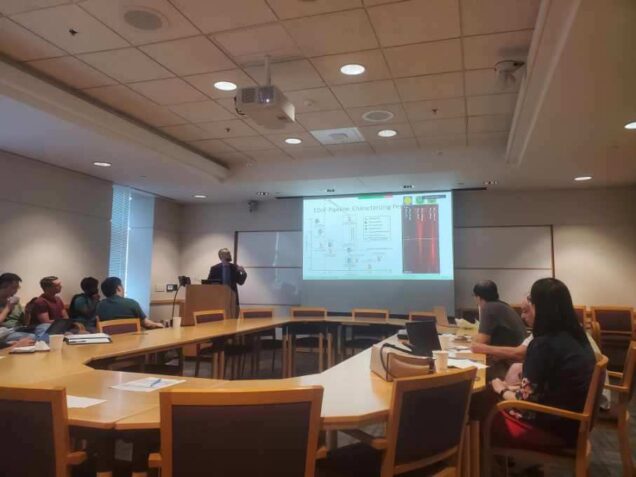6th PhD of Tian lab: Joseph Greene!

Computational Extended Depth of Field Fluorescence Microscopy in Miniaturized and Tabletop Platforms
Advisor: Professor Lei Tian
Committee: Professor Jerome Mertz, Professor Janusz Konrad, Professor Abdoulaye Ndao, Professor Xiaojun Cheng, Professor Tianyu Wang
Thursday, June 20, 2024
12:00 p.m. – 2:00 p.m.
Abstract
Fluorescence microscopy has emerged as a powerful solution to enable the direct study of biological compounds by labelling key structures and dynamics with optically responsive fluorophores to push fields ranging from medicine to biology to neuroscience. Due to its low-cost, flexible architecture and widefield imaging capabilities, one-photon epi-fluorescence microscopes have emerged as a standard platform for interrogating samples both in miniaturized and tabletop applications in real time. However, these systems are plagued by the low power of fluorescence samples, a lack of optical sectioning, susceptibility to scattering and shallow optical depth-of-field (DoF). As a result, collected signals exhibit low signal-to-noise and signal-to-background, high aberration and emerge from a constrained volume near the surface of the sample. To overcome these challenges, this thesis introduces several flexible and generalizable computational imaging frameworks to co-optimize custom optics and algorithms to encode target signals over a significantly enlarged extended depth of field (EDoF) then computational extract those signals from the high perturbations. This design paradigm fundamentally relies on concepts of pupil engineering, which uses a Fourier optics description of light propagation to design custom flat phase masks on the often-vacant pupil plane of a standard microscope to perform optical encoding.
This thesis begins by introducing a novel miniaturized EDoF-enabled miniscope, entitled EDoF-Miniscope, to motivate the utility of EDoF fluorescence imaging in a miniaturized form factor and on the complex environment of the brain. This project utilizes an innovative genetic algorithm to optimize a miniaturized and lightweight binary diffractive optical element (DOE) on the pupil plane to extend the DoF over 2.8x utilizing twin imaging foci. This project represents the first successful integration of diffractive optics into a miniscope to enable unprecedented control of the optical field inside the brain. To keep EDoF-Miniscope broadly accessible, I then utilize a simple off-the-shelf post-processing filter which enables the recovery of neuronal sources down to an SBR of 1.08. Next, I seek to improve upon the proposed framework in several capacities by designing a flexible 1-photon widefield tabletop testbed that exhibits comparable field-of-view (FoV), NA and aberrations to a miniscope entitled EDoF-Tabletop. This platform utilizes a spatial light modulator (SLM) on the pupil plane to rapidly deploy optimized phases without the need of manufacturing and aligning miniaturized optics. To improve both the optimization of novel pupil phases as well as the reconstruction algorithm, EDoF-Tabletop incorporates a novel end-to-end deep learning pipeline. Innovative physical modeling, optimization and initialization strategies are employed to make the framework computationally efficient, stable and reliably converge to the desired EDoF without the need for explicit initialization. By incorporating rigorous physical modeling, this thesis is able to perform cutting edge encoding and recovery of sources up to 140 microns (1.4 scattering lengths) deep in scattering media or over 400 microns deep in non-scattering samples without sacrificing the NA (NA=0.5), speed nor form factor.
Sponsoring a flexible optimization pipeline with a co-optimized reconstruction network and highly accurate physical simulator, the EDoF pipeline presented in this thesis offers a generalized solution for developing pushing fluorescence microscopy. By demonstrating this technology across miniaturized and tabletop platforms as well as across a broad range of fluorescence and biological samples, I believe that this framework will continue to push the practicality of 1-photon fluorescence imaging across a wide range of fluorescence imaging applications.